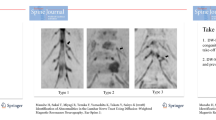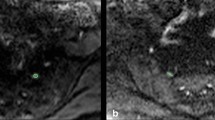Abstract
Purpose
Lumbar nerve root entrapment syndromes cause radicular signs and symptoms in the affected leg. The applicability of diffusion-weighted imaging (DWI) for the assessment of lower lumbar nerves (L4–S1) has been demonstrated. The purpose of this pilot study was to establish DWI reference data for the all lumbosacral nerve roots (L1–S1) in a healthy, asymptomatic study population and to determine its potential as a diagnostic tool for patients with lumbar radicular syndromes.
Methods
20 asymptomatic healthy volunteers were included (average age 39 years (24–59 years; n = 10 female, n = 10 male). The lumbosacral spine was scanned twice in a standardized fashion (1.5 T Magnetom Avanto and 3 T Magnetom Skyra, Siemens AG Healthcare, Erlangen, Germany). A spin-echo type echo-planar (SE-EPI) sequence was used to determine axial ADC maps and measurements (length, width, and angulation) of the dorsal root ganglion (DRG) and distal spinal nerves (DSN). Disc pathology, lumbar foraminal stenosis and nerve root compromise were classified.
Results
Using 3 T images 218 (91 %) lumbar nerve roots had no pathologic finding [1.5 T: 226 (94 %)]. All DRG and DSN could be visualized and identified on axial apparent diffusion coefficient (ADC). On average we measured ADC values of 1,231 mm2/s (SD 308 mm2/s) at the DRG for the 1.5 T scanner and 1,756 mm2/s (SD 465 mm2/s) for the 3 T scanner. There were no statistically significant gender or side differences in the 1.5 and 3 T images (p > 0.05). We noted an increase of the ADC values starting from cranial (L1: 1,444 mm2/s) to caudal (S1: 1,918 mm2/s). The average ADC value at the DSN was 1,018 mm2/s for the 1.5 T scanner compared to 1,589 mm2/s for the 3 T scanner (p < 0.001).
Conclusions
For the first time, we have established data for the DRG and DSN in human lumbosacral spinal nerves (L1–S1), using diffusion-weighted magnetic resonance imaging techniques. 3 T ADC maps have a higher signal to noise ratio, thus offering better image quality. Results from this study suggest that DWI has added value as new diagnostic tools for patients with symptomatic lumbar nerve root entrapment syndromes as well.

Similar content being viewed by others
Notes
Abramoff MD et al (2004) Biophotonics International 11:36–42
References
Arnoldi C, Brodsky A, Cauchoix J et al. (1976) Lumbar spinal stenosis and nerve root entrapment syndromes. Definition and classification. Clin Orthop Relat Res (115):4–5
Aota Y, Niwa T, Yoshikawa K et al (2007) Magnetic resonance imaging and magnetic resonance myelography in the presurgical diagnosis of lumbar foraminal stenosis. Spine 32:896–903. doi:10.1097/01.brs.0000259809.75760.d5
Herron LD (1989) Selective nerve root block in patient selection for lumbar surgery: surgical results. J Spinal Disord 2:75–79
Floeth FW, Stoffels G, Herdmann J et al (2011) Prognostic value of 18F-FDG PET in monosegmental stenosis and myelopathy of the cervical spinal cord. J Nucl Med 52:1385–1391. doi:10.2967/jnumed.111.091801
Eguchi Y, Ohtori S, Yamashita M et al (2010) Clinical applications of diffusion magnetic resonance imaging of the lumbar foraminal nerve root entrapment. Eur Spine J 19:1874–1882. doi:10.1007/s00586-010-1520-9
Transfeldt E, Macnab I (2007) Macnab’s Backache. Lippincott Williams & Wilkins, New York
Pfirrmann CWA, Dora C, Schmid MR et al (2004) MR image-based grading of lumbar nerve root compromise due to disk herniation: reliability study with surgical correlation. Radiology 230:583–588. doi:10.1148/radiol.2302021289
Lee S, Lee JW, Yeom JS et al (2010) A practical MRI grading system for lumbar foraminal stenosis. Am J Roentgenol 194:1095–1098. doi:10.2214/AJR.09.2772
Park HJ, Kim SS, Lee SY et al (2012) Clinical correlation of a new MR imaging method for assessing lumbar foraminal stenosis. AJNR Am J Neuroradiol 33:818–822. doi:10.3174/ajnr.A2870
Sugawara O, Atsuta Y, Iwahara T et al (1996) The effects of mechanical compression and hypoxia on nerve root and dorsal root ganglia. An analysis of ectopic firing using an in vitro model. Spine 21:2089–2094
Shen J, Wang H-Y, Chen J-Y, Liang B-L (2006) Morphologic analysis of normal human lumbar dorsal root ganglion by 3D MR imaging. AJNR Am J Neuroradiol 27:2098–2103
Kuijper B, Tans JTJ, van der Kallen BF et al (2011) Root compression on MRI compared with clinical findings in patients with recent onset cervical radiculopathy. J Neurol Neurosurg Psychiatr 82:561–563. doi:10.1136/jnnp.2010.217182
Wassenaar M, Rijn RM, Tulder MW et al (2011) Magnetic resonance imaging for diagnosing lumbar spinal pathology in adult patients with low back pain or sciatica: a diagnostic systematic review. Eur Spine J 21:220–227. doi:10.1007/s00586-011-2019-8
Song T, Chen W-J, Yang B et al (2011) Diffusion tensor imaging in the cervical spinal cord. Eur Spine J 20:422–428. doi:10.1007/s00586-010-1587-3
Roberts N, Hogg D, Whitehouse GH, Dangerfield P (1998) Quantitative analysis of diurnal variation in volume and water content of lumbar intervertebral discs. Clin Anat 11:1–8. doi:10.1002/(SICI)1098-2353(1998)11:1<1:AID-CA1>3.0.CO;2-Z
Kingsley MI, D’silva LA, Jennings C et al (2012) Moderate-Intensity running causes intervertebral disc compression in young adults. Med Sci Sports Exerc 44:2199–2204. doi:10.1249/MSS.0b013e318260dbc1
Conflict of interest
None.
Author information
Authors and Affiliations
Corresponding author
Appendix
Appendix
Appendix 1
a 3 T coronal diffusion-weighted image of L4–L5 nerve roots with a better signal to noise ratio (SNR) but higher degree of distortion artifacts, e.g., presumed “kinking” of distal lumbar nerve, b Corresponding 1.5 T diffusion-weighted image with lower SNR, e.g., slightly more “diffuse” image appearance
Appendix 2
Rights and permissions
About this article
Cite this article
Reinhold, M., Ederer, C., Henninger, B. et al. Diffusion-weighted magnetic resonance imaging for the diagnosis of patients with lumbar nerve root entrapment syndromes: results from a pilot study. Eur Spine J 24, 319–326 (2015). https://doi.org/10.1007/s00586-014-3602-6
Received:
Revised:
Accepted:
Published:
Issue Date:
DOI: https://doi.org/10.1007/s00586-014-3602-6








